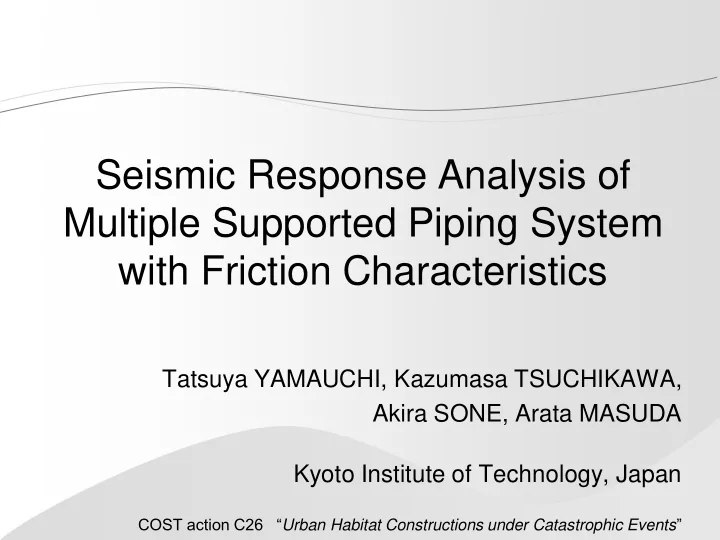

Seismic Response Analysis of Multiple Supported Piping System with Friction Characteristics Tatsuya YAMAUCHI, Kazumasa TSUCHIKAWA, Akira SONE, Arata MASUDA Kyoto Institute of Technology, Japan COST action C26 “ Urban Habitat Constructions under Catastrophic Events ”
Background and Purpose Since large plants have been increasing in recent years, seismic designs of piping systems in such facilities have been taken more seriously. In perspective of streamlining of designs, the response analysis of multi-input nonlinear system is needed. This is a basic study for proposing a calculation method of maximum response of multiple supported piping systems with friction characteristics. The effect of correlation between two support excitations on the maximum response of piping system is investigated.
Analytical Model of Piping System Consider a single-degree-of-freedom piping system subjected two support excitations as shown. ; mass of pipe ; damping coefficients of support 1, 2 ; spring constants of support 1, 2 ; absolute displacement of pipe ; two support displacement inputs ; friction force between the pipe and support 1 Schematic drawing of piping system Analytical model
Response Calculation Formula For simplicity, taking as , , the equation of motion of this piping system is given as where is the relative displacement response, The friction characteristics are assumed to be as the Coulomb friction model . As the nondimensional parameter corresponding to friction effect, the following parameter is used. In order to calculate the above equation of motion, the switching condition between the sliding and the rest is necessary.
Switching Condition The relative acceleration of pipe is given as Comparison The switching condition from the sliding to the rest When this equation is satisfied, the responses of pipe are given as The switching condition from the rest to the sliding
Generation Method for Two Inputs Two support excitations and are simulated through the Monte Carlo method . The cross-correlation among support excitations Where is a standard deviation of , is correlation factor between two excitations, is a constant value which gives the shape of the cross-correlation, and is a predominant circular frequency of generated excitation. In this study, these values are set as below. Type 1 Type 2 Type 3 Type 4 1 10 1 10
Generated Inputs Type 1 ( ) These are relatively narrow- band excitations. The predominant frequencies are 5 Hz. The cross-spectrum The time histories The power spectra of and
Generated Inputs Type 2 ( ) These are relatively broad- band excitations. The predominant frequencies are about 5 Hz. The cross-spectrum The time histories The power spectra of and
Numerical Simulation Maximum acceleration responses for Type 1-excitations (linear piping system) The maximum acceleration responses increase with increase of correlation coefficient between two inputs.
Numerical Simulation Maximum acceleration responses for Type 1-excitations (nonlinear piping system) For Type 2-4 excitations, the same results are obtained The maximum acceleration responses increase However , the maximum acceleration responses for this with increase of correlation coefficient between two inputs. case become smaller than those for linear case.
Response Reduction Factor The following response reduction factors are defined based on the linear maximum response. ; maximum acceleration response ; maximum relative velocity response ; maximum relative displacement response of nonlinear piping system ; maximum acceleration response ; maximum relative velocity response ; maximum relative displacement response of linear piping system ; response reduction factor for maximum acceleration response, relative velocity response, relative displacement response, respectively
Response Reduction Factor For acceleration response For relative velocity response All response reduction factors become large with increase of . In the region of , response reduction factors almost keep constant. For relative displacement response
Conclusions (1)The maximum responses of linear piping systems can be calculated depending on the correlation coefficient between two input excitations. In other words, the stronger the correlation coefficient becomes, the higher these values grow. (2)This relationship becomes the same results in the case of small friction force, however, in the case of large friction force, it is not clearly seen. (3)The response reduction factors due to friction effect become large in the case of large correlation coefficient between two input excitations.
Thank you for your kind attention.
Background The damages of pipes in industrial facilities by a large earthquake may cause the second disasters such as fire and discontinuance of energy supply. Seismic designs of piping systems are very important For seismic response analysis of multiple supported piping systems in industrial facilities such as nuclear power plants and petro-chemical plants, the several calculation methods have been proposed. However the methods are not applicable to nonlinear systems. On the other hand, there have been some investigations of the dynamic response characteristics of piping systems considering the nonlinearities such as friction. However they are all on the single input systems.
Purpose In perspective of streamlining of designs, the response analysis of multi-input nonlinear system is needed This is a basic study for proposing a calculation method of maximum response of multiple supported piping systems with friction characteristics. The effect of correlation between two support excitations on the maximum response of piping system is investigated. Using a simple analytical model of single-degree- of-freedom system with friction to two inputs, numerical simulations are carried out with various correlation cases of two inputs.
Numerical Simulation Reduction effect of maximum response due to friction characteristics As amplification factor , the ratio of maximum acceleration response and maximum input acceleration is defined as The amplification factor almost becomes smaller with increase of , irrespective of correlation coefficient. However , for large values and , the difference among due to every correlation coefficients Relationship between and is not clear and fluctuates . for Type 1-excitationa and
Recommend
More recommend